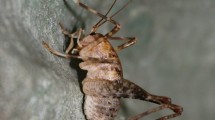Summary
-
1.
Responses of the leg vibratory receptor neurons of the bugNezara viridula to substrate vibrations were recorded electrophysiologically and analysed.
-
2.
The low frequency receptor neurons (LFR) respond in a phase-locked manner in the frequency range below 0.12 kHz. The low frequency receptor neurons of the first type (LFR 1) have been analysed in detail. Receptor neurons of this type respond to the upward movement of the leg in a vibration cycle. Their threshold curves follow the line of equal displacement values above 0.05 kHz of the stimulus carrier frequency (Fig. 1). Increasing displacement brings about an increase in the number of spikes per phase (Fig. 2).
-
3.
The higher frequency vibratory receptor neurons are of two types. The middle frequency receptor neurons (MFR) show the highest sensitivity to the velocity component of vibration at frequencies around 0.2 kHz (Fig. 1); the high frequency receptor neurons (HFR) are most sensitive to velocity at frequencies between 0.75 and 1 kHz (Fig. 1). In the frequency range below the best velocity sensitivity, the threshold curves of both types of neurons follow the line of equal acceleration values; above the best frequency the curves follow the line of equal displacement values (Fig. 1). The shapes and positions of the response curves of both types depend on the stimulus carrier frequency (Fig. 3). The middle (MFR) and high frequency receptor neurons (HFR) respond with characteristically prolonged responses to applied vibrational stimuli of 0.2 kHz carrier frequency (Figs. 4–6). The phase-locked response pattern is observed in both neuron types in the frequency range up to 0.2 kHz (Figs. 4–6).
-
4.
The frequency and time characteristics of the femaleNezara viridula calling song (FS 1) are well followed by the middle (MFR) and high frequency receptor neurons (HFR) (Figs. 7, 8), but the low frequency receptor neurons (LFR) follow the lower frequency components of the same female sound emission only at higher displacement values.
-
5.
The origins of the responses of the low (LFR), middle (MFR) and high frequency receptor neurons (HFR) are discussed. The special response characteristics of the higher frequency receptor neurons, i.e. the middle (MFR) and high frequency (HFR) receptor neurons, at 0.2 kHz stimulus frequency may be due to the resonance of the special flaglike structure of cap cells of the subgenual organ.
Similar content being viewed by others
Abbreviations
- LFR :
-
low frequency receptor neurons
- MFR :
-
middle frequency receptor neurons
- HFR :
-
high frequency receptor neurons
References
Autrum H, Schneider W (1948) Vergleichende Untersuchungen über den Erschütterungssinn von Insekten. Z Vergl Physiol 31:77–88
Burns MD (1974) Structure and physiology of the locust femoral chordotonal organ. J Insect Physiol 20:1319–1339
Čokl A, Amon T (1980) Vibratory interneurons in the central nervous system ofNezara viridula L. (Pentatomidae, Heteroptera). J Comp Physiol 139:87–95
Čokl A, Bogataj E (1982) Factors affecting vibrational communication inNezara viridula L. (Heteroptera, Pentatomidae). Biol Vestn 30:1–20
Čokl A, Kalmring K, Wittig H (1977) The responses of auditory ventral-cord neurons ofLocusta migratoria to vibration stimuli. J Comp Physiol 120:161–172
Čokl A, Gogala M, Blaževič A (1978) Principles of sound recognition in three pentatomide bug species (Heteroptera). Biol Vestn 26:81–94
Debaisieux P (1938) Organes scolopidiaux des pattes d'insectes. Cellule 47:77–202
Devetak D, Gogala M, Čokl A (1978) A contribution to the physiology of vibration receptors in the bugs of the family Cydnidae (Heteroptera). Biol Vestn 26:131–139
Gogala M, Čokl A, Drašlar K, Blaževič A (1974) Substrateborne sound communication in Cydnidae (Heteroptera). J Comp Physiol 94:25–31
Howse PE (1964) An investigation into the mode of action of the subgenual organ in the termite,Zootermopsis angusticollis Emerson and in the cockroach,Periplaneta americana L. J Insect Physiol 10:409–429
Kühne R (1982) Neurophysiology of the vibration sense in locusts and bushcrickets: response characteristics of single receptor units. J Insect Physiol 28:155–163
Kühne R, Lewis B, Kalmring K (1980) The responses of ventral cord neurons ofDecticus verrucivorus (L.) to sound and vibration stimuli. Behav Proc 5:55–74
Markl H (1970) Die Verständigung durch Stridulationssignale bei Blattschneiderameisen. III. Die Empfindlichkeit für Substratvibrationen. Z Vergl Physiol 69:6–37
Rheinlaender J (1975) Transmission of acoustic information at three neuronal levels in the auditory system ofDecticus verrucivorus (Tettigoniidae, Orthoptera). J Comp Physiol 97:1–53
Schneider W (1950) Über den Erschütterungssinn von Käfern und Fliegen. Z Vergl Physiol 32:287–302
Schnorbus H (1971) Die subgenualen Sinnesorgane vonPeriplaneta americana: Histologie und Vibrationsschwellen. Z Vergl Physiol 71:14–48
Usherwood PNR, Runion HI, Campbell JI (1968) Structure and function of a chordotonal organ in the locust leg. J Exp Biol 48:305–323
Wiese K (1972) Das mechanorezeptorische Beuteortungssystem vonNotonecta. I. Die Funktion des tarsalen Scolopidialorgans. J Comp Physiol 78:83–102
Young D (1970) The structure and function of a connective chordotonal organ in the cockroach leg. Philos Trans R Soc Lond [Biol] 256:401–428
Author information
Authors and Affiliations
Rights and permissions
About this article
Cite this article
Čokl, A. Functional poperties of viboreceptors in the legs ofNezara viridula (L.) (Heteroptera, Pentatomidae). J. Comp. Physiol. 150, 261–269 (1983). https://doi.org/10.1007/BF00606376
Accepted:
Issue Date:
DOI: https://doi.org/10.1007/BF00606376




